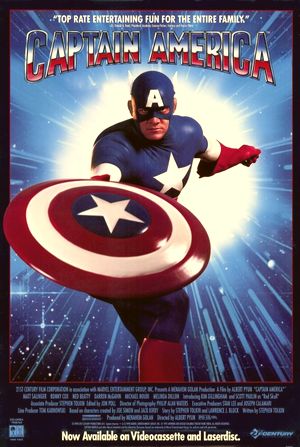Other Reviews in this Series.
Director: Albert Pyun
Writers: Stephen Tolkin, Lawrence Block
Cast: Matt Salinger, Kim Gillingham, Ronny Cox, Ned Beatty, Scott Paulin
Runtime: 97 mins.
1990
The 1990 American-Yugoslavian direct-to-video action film Captain America is the first cinematic adaptation of the character with some semblance of attention paid to the actual character. The first act plays out like a truncated version of Captain America: The First Avenger, with Cap being selected for the Super Soldier Serum, then squaring off against the Red Skull. Cap gets strapped to a rocket that he steers away from the White House and into, if I'm not mistaken, Alaska. After being frozen for about fifty years, Steve Rogers (Matt Salinger) breaks free from the ice and traipses from Alaska down through northern Canada in an attempt to find his way home. At first he does not accept that he is fifty years in the future, but this is a thematic and plot thread that predictably goes nowhere. Instead of exploring his man-outside-of-time psychology, Rogers teams up with his old girlfriend's daughter (a bit gross) and goes after the Red Skull, who is still alive and has recently kidnapped the President (Ronny Cox) because he doesn't like the President's environmental bill. Also, the Red Skull has had face reconstruction surgery since the forties so he no longer has a red skull, just an ugly face.
Captain America may engage with the iconography on the surface level, but as you can probably tell by that recap, the film isn't terribly interested in exploring why the character resonates. It probably would have been better served as a cheesy period piece, but the narrative break between WWII and present day is jarring and disappointing, especially since most of the rest of the movie involves Captain America trekking across the Canadian wilderness in his goofy suit, or sitting around in suburbia acting awfully calm for somebody who has just time traveled fifty years into the future.
The fact that the Red Skull is still around fifty years later, but has waited until now for his most dastardly plot, is also distressing from a storytelling perspective. Plus, taking away his iconic look feels like a cop out at best.
Captain America himself isn't particularly engaging either. The reason he gets strapped to the rocket in the first place is because he sprints into the Red Skull's base like a fool. A good Captain America story needs to draw a clear line between bravery and idiocy, and this film fails at that task. Salinger's Steve Rogers is little more than a blank. His defining character moment is this bizarre running gag where he keeps telling people that he's getting carsick so that when they get out of the car, he can run around to the driver's seat and steal the vehicle. It's a goofy trick, and one of his only real character beats, and a decidedly un-Captain-American thing to do. Not to mention that as far as aesthetics go, he wears the suit even worse than the 1979 iteration. Salinger is handsome enough, but as soon as he puts on the mask he looks like an absolute goon.
It's curious to consider just how rare it was for a creative team to really crack a good superhero movie before 2000's X-Men. Beyond your odd Superman or Batman success stories, you got a litany of titles that boasted little to no grasp over what made their characters special. The first step is capturing the iconography, of course, but there needs to be something beyond that. Comic books are a fascinating mythbuilding medium. They allow characters to morph over the course of decades, because these stories must both fit the time in which they are written and be true to timeless characters. As such, the mythology of each superhero tends to get boiled down to pure philosophical and ideological essentials: the essentials that must be present for the character to truly be present.
X-Men tapped into the political-postmodern ethos of the titular characters in a grounded way that also reflected the time in which it was made. Raimi's Spider-Man movies doubled down on that by presenting a character, warts and all, in the glory of comic book soap opera camp, without shame or trepidation. And now, ever since 2008's Iron Man, the Disney-Marvel machine has been churning out adaptations that effectively cut to the quick of what we know and love about these larger than life figures.
Captain America may boast the correct iconography--red white and blue suit, man outside of time, boomerang shield, Red Skull villain--but it lacks anything resembling the heart of Steve Rogers. Captain America lacks the subtext that makes superhero films such an appealing genre, instead grafting familiar visuals to a wholly generic 80's/90's action B-movie plot. Cap has a spunky female sidekick. People get shot with Verhoeven-lite brutality. Captain America teams up with the president to foil the terrorist plot of a conspicuously European megalomaniac. While a story like that could belong in a Captain America comic, it is presented here as a whole lot of punching with very little justification or ethos. Captain America is simply a shell for half-assed jingoism, the kind of airheaded character many of us assumed him to be until the MCU put his most compelling aspects on display.
0.5 / 5 BLOBS




No comments:
Post a Comment